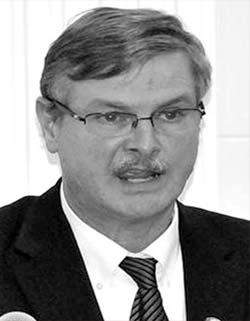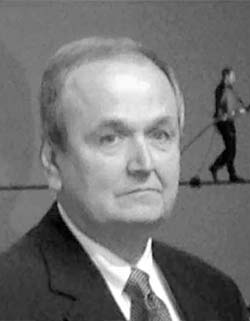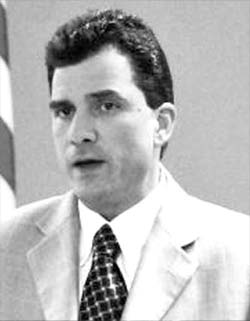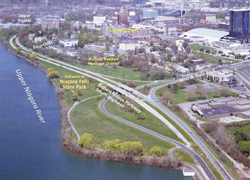Dyster Supports State Parks Interest Over City Business
By Frank Parlato
The Niagara Falls State Park, the most visited state park in the US, makes the State of New York a lot of money through its business enterprises.
Due to the nature of those businesses, the park is, however, in directcompetition with many of the private businesses in the city.
Anyone who knows anything about this competition knows that, historically, the state usually wins, siphoning to Albany much of the tourist revenue the city, which gets six million visitors a year, would normally expect to receive.
The result is a weak downtown, where city businesses typically get the leftover tourist business the parks can’t accommodate on busier days during the summer season.
It is not for no reason that Niagara Falls is facing insolvency, its people impoverished, with the stores, homes and businesses nearest the park empty and struggling to survive.
Of course, a business competition pitting a state park against the people is not the way most state parks operate.
In fact, in the city, there is growing resentment of this fact.
When State Parks Deputy Director Mark Thomas, in charge of the Niagara Falls State Park, appeared last at a public hearing, more than 300 people spontaneously booed him after he said the state park was here to help the people of the city.
Thomas has avoided all large public meetings in Niagara Falls since.
Oddly, Niagara Falls Mayor Paul Dyster has consistently weighed in on the side of the State Parks even when it is not, as it usually isn’t, in the best interest of the city.
He may have crossed the line at times, and overreached his authority in his desire to help Albany interests.
For example, New York State Parks spent a lot of public money to create a plan to modify the section of the Robert Moses Parkway that runs from John B. Daly Boulevard to the Niagara Falls State Park.
This section, known as the "South Segment," is not to be confused with the North Segment of the Robert Moses that runs from Niagara Falls into Lewiston, which is also being studied.
To redesign the south segment, State Parks hired Hatch Mott MacDonald, Alta Planning & Design, Heritage Landscapes, Saratoga Associates, the
Urban Design Project and Watts Architecture & Engineering.
The plan they came up with is known as the Riverway Plan.
If approved and implemented, the Riverway Plan will see the Robert Moses Parkway converted from a two-way, 55 MPH roadway to a slower, one-way road that leads, as the Robert Moses currently does, directly from the Interstate 90 to the Niagara Falls State Park.
To pay for this plan, State Parks used money from the U.S. Department of Transportation, the Federal Highway Administration, the New York State Department of Transportation, USA Niagara Development Corporation and oddly, with Dyster's approval, the City of Niagara Falls.
It is ironic that the impoverished City of Niagara Falls is paying to help the state create a plan that routes motorists on a state road to the state park without even getting a look at the city.
It reminds one of the Aesop Fable of the eagle that was shot by an arrow made with eagle feathers.
Since the park has numerous restaurants, gift and souvenir stores, a banquet business, vending locations and paid parking lots, it is obvious why State Parks prefers the Riverway Plan.
The plan removes embankments, adds landscaping and builds footpaths, which will improve the appearance of the park. More significantly, the plan's one way road - leading toward the park will better ensure that tourists won’t turn around and go into the city after coming off the Interstate.
State Parks admits this is their goal in their presentation package for the Riverway plan: “One of the major concerns is that (removing the parkway) does not provide direct access to the State Park from the U.S. interstate system, which is how the majority of park visitors get to the park.”
Before the Robert Moses Parkway was built in the early 1960's, motorists had to drive through the city to get to the park.
The park had few businesses then, little parking and little appetite to compete with the city. Consequently, the local merchants got all the tourist business, the city thrived and many residents operated seasonal businesses that added to the wealth and spending here.
After the Parkway was created, former Mayor Michael O'Laughlin described it as the "Great Wall of China" because, he said, astutely, that it cut off the park from the tourist businesses in the city.
In January, guided by his former city manager and present State Parks Commissioner, Harvey Albond, the Niagara Falls City Council unanimously rejected the Riverway plan.
Albond told the council, "I see no use for this (Riverway) plan other than to bypass the city."
Agreeing with Albond, the council said it prefers that the entire south segment of the Robert Moses Parkway be removed, which would result in tourists once again driving through the city before entering the park, allowing local businesses to have the first chance at parking, souvenir, tour and restaurant trade.
With the council voting against the Riverway Plan, one man rose to stand in the way. Mayor Dyster appears to be the only elected city official and, perhaps, the only city resident, who supports the state's plan.
In feeding the public and the media the lie that the Riverway Plan is a done deal, Dyster said he has been working with State Parks on the parkway redesign for several years, and that, while he agrees with the "sentiment" of the council’s resolution to eliminate the south segment of the parkway, he feels the Riverway plan is the result of "compromise."
A compromise?
Is State Parks relying on some hidden agreement with the city, which
Dyster calls a compromise?
This "compromise" made by the mayor with the State Parks was apparently done without consulting the council or the public.
The public was surprised that the mayor was cheerleading against their interests when State Parks presented the plan for comment.
After all, since the parkway is in the city, the city has a say, as the principal stakeholder. In fact State Parks needs the city's consent to move forward on the Riverway plan.
Did Dyster give that consent before the plan had a chance to be aired and discussed by the people and the council?
"The design may not be exactly what everyone wanted," Dyster said, "but it serves everyone's interests and it's a whole lot better than what we have now."
But Dyster was not elected to serve "everyone's interests." He was elected to serve the city’s interests, even to the exclusion of competing interests.
If there is a signed agreement between Dyster and the State Parks, it may be illegal since the mayor needs council approval to sign contracts.
Why hasn't the mayor called for a public hearing on whether the city should push for the removal of the parkway?




-2_copy 250.jpg)